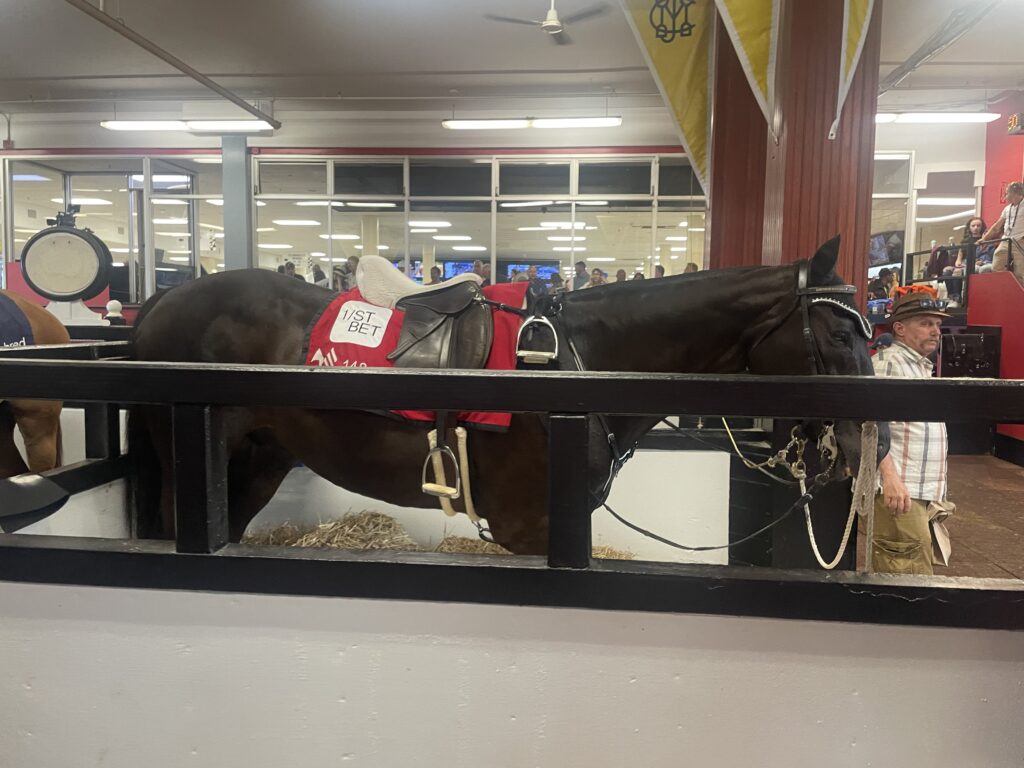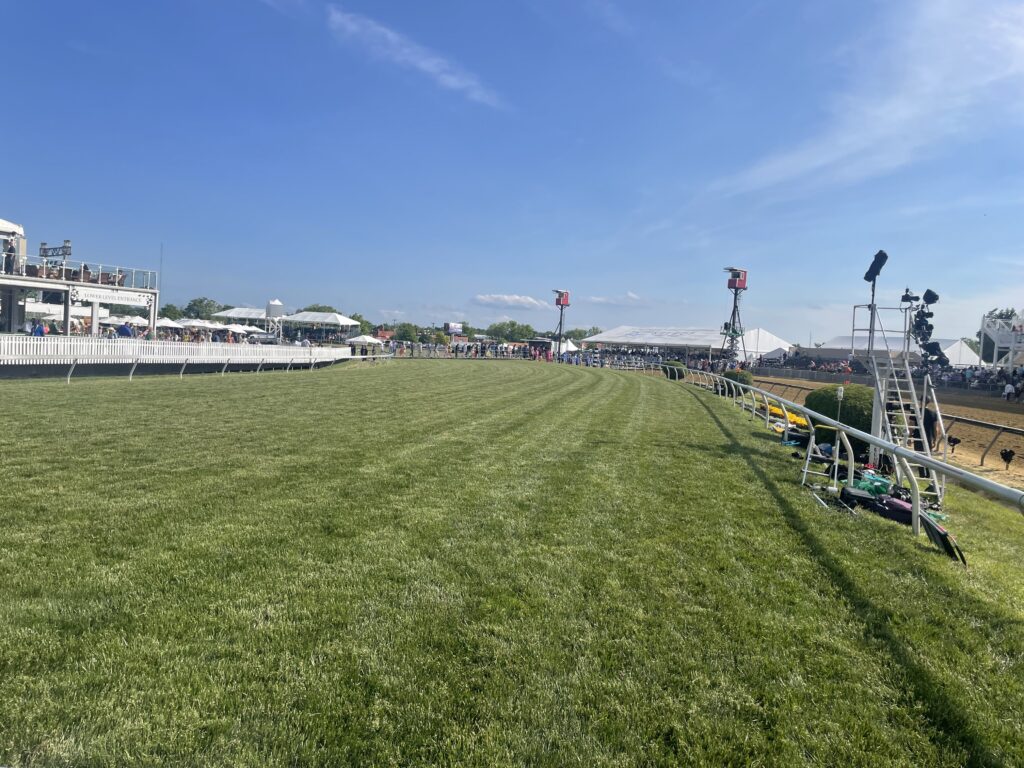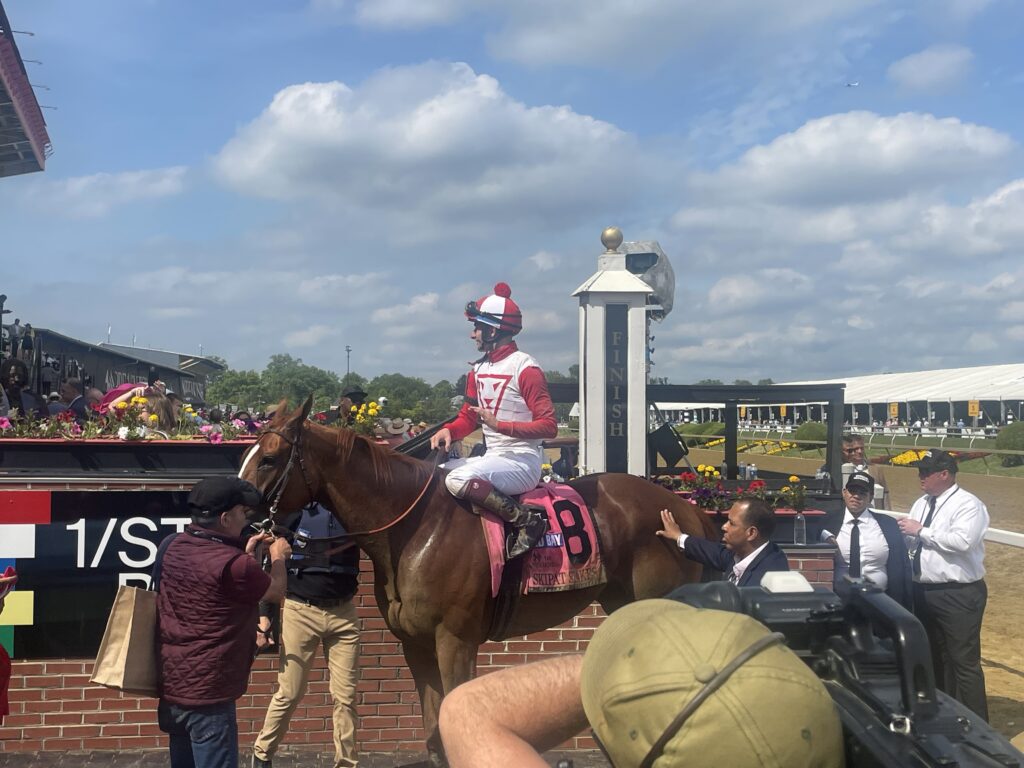“Then Things Went Bad”: How I Won $264 at Preakness
There’s a shortage of good signs en route to the Preakness Stakes, the annual horse race in Baltimore best known as the Kentucky Derby’s older, less attended sibling. By good, I mean the useful types that tell you where to go. There are plenty of other kinds: ads stationed outside delis; DIY posters offering lawns, driveways, and other car-size surfaces as extremely pricey parking options; at least two hotel-related banners on propeller planes; and sandwich boards affixed to roving scalpers, which read, counterintuitively, I NEED TICKETS. The result is a ring of confused, directionless traffic around the track, where it’s easy to forget that everyone has come for a spectacle essentially premised on speed.
The lack of organization at the Preakness is appropriate; horse racing is America’s least centralized sport. There is no MLB or NFL or NBA or NHL for this game. There is a panoply of jockey clubs, trainers groups, state racing boards, owners associations, and veterinarian organizations. The racing rules change from state to state. The racing seasons change from track to track. Even the kind of race a horse runs may fluctuate with the weather. This tradition of casually maintained chaos is almost a point of pride. In 2020, when Congress passed the Horseracing Integrity and Safety Act (HISA)—a modest attempt to standardize antidoping rules across the industry—it was met with three years of bitter infighting, five federal lawsuits challenging its constitutionality, and most recently, an exquisitely melodramatic public letter from the U.S. Trotting Association that opens with a Thomas Paine quote. That is to say, it’s in the spirit of horse racing that, this past Saturday, as I approached the venue, I had no idea where to go or who was in charge, and neither, seemingly, did anyone there.
The venue was Pimlico Race Course. Of the many contrasts to be drawn between the Derby and the Preakness, most land in the former’s favor. The track is one of them. The Kentucky Derby is run at Churchill Downs—a 147-acre complex in Louisville whose 170,000-person capacity, hexagonal twin spires, and $121 million Bush Jr.–era renovation make it one of the largest, most recognizable, and most opulent race courses in the country; Pimlico isn’t even the nicest option in Maryland. It’s the second oldest racetrack in the U.S. and doesn’t look a day younger, though parts of it technically are. The original clubhouse—a “Steamboat Gothic-era” “rambling wooden Victorian confection,” as one Baltimore Sun article put it—burned to the ground in a 1966 electrical fire, leaving only a horse-and-jockey-shaped weather vane behind. The newer clubhouse, built a few years before the fire, seems to take most of its architectural influence from high school gymnasiums and the DMV. It is also, however, awesome, if you like these things more for the money and big fast animals than for the antebellum theatrics.
The clubhouse was white, brick, and not entirely full. Live racing attendance has been on a downward slide since the Reagan administration, and the pandemic and the rise of online betting platforms have only sped up the process. In 2022, Pimlico’s owners—a company formerly known as the Stronach Group, now operating under the dubiously pronounceable name 1/ST—made a play for younger audiences by setting up a music festival just off the track. This sounds like a good idea, and last year, with Megan Thee Stallion headlining alongside Lauryn Hill, it may have succeeded in bringing the median age of attendees down by a decade (in 2021, it was sixty-five). This year’s bill featured Sofi Tukker—a dance music duo comprised of a girl named Sophie and a guy named Tucker, which broke out seven years ago with a single called “Drinkee”—and Bruno Mars, an artist with fifteen Grammys and, based on the turnout, maybe as many fans. Between Friday and Saturday, racetrack and festival, this year’s event drew just 65,000 people—barely a third of the 182,000 who came out in 2019.
As far as I was concerned, fewer people was a plus. I’d come mainly to eavesdrop and maybe make some money. Both goals turned out to be somewhat optimistic. I like to think of myself as a gambler, but it’s one of those semiflattering self-assessments that holds more water in theory than in practice. In theory, I love fast payouts, their stereotypical accessories (casinos, croupiers, the outfits croupiers wear at casinos), and pretty much every movie about those things. In practice, I follow sports and stocks absentmindedly at most and, during various stretches in Vegas, lost more money at the in-house Starbucks than at any card table. I am a sore loser and constitutionally cheap, meaning most of my bets are low in value, long in odds, and cashed out quickly.

Photograph by Tarpley Hitt.
As far as eavesdropping, the acoustics seemed best suited for minding your own business. Even with the lower turnout, the place sounded packed. I’d hoped to hear gossip about the eight horses that had died at Churchill Downs since April, or about the return of the disgraced trainer Bob Baffert, who was suspended from last year’s Triple Crown races after his Derby-winning horse, Medina Spirit, tested positive for pain meds in 2021. It wouldn’t have hurt if guests had thrown in some sad musings about the declining state of the sport. But the audible conversation proved a little more literal. “I’m wearing my big hat,” a woman in a big hat said to her boyfriend, “for good luck.” The food vendors trailed lines of men in identical beige caps; they all read MAGE, for the Kentucky Derby winner who would be running later that night. “I called my investment manager the other day and told him to put everything in money-market funds,” one guy told the MAGE men. “He says to me, ‘Those only yield five percent.’ And I say, ‘Exactly.’ ”
At the ticket windows, would-be winners barked long lists of bets—exactas (on the first- and second-place finishers in a single race), trios (on the first three finishers in a single race), and daily doubles (on first-place finishers in two consecutive races), as an MSNBC presenter gestured at racing stats for TV cameras nearby. “That’s the election guy,” one girl announced to her group. It was. If Steve Kornacki was giving good advice, no one could hear it. But few cared about Preakness stats anyway. The goofiest part of horse racing is how short it is; from starting bell to finish line, a race lasts all of two minutes. If everyone came just for the main event, they’d be headed home as soon as they parked. The Preakness program is stacked instead with undercards boasting smaller purses and cryptic names (the $200,000 “Dinner Party Stakes”). It gives the day a predictable rhythm: twenty minutes of research, betting, and crab-cake buying; ten minutes of finding a clear view of the finish line; one minute of watching; thirty seconds of screaming variations of “COME ON, NUMBER NINE!”
It’s easy to get swept up in this cyclical game to the point where its harsher realities barely register. During the sixth race, for example, a horse was rounding the home stretch when it stumbled. The jockey fell to the dirt. But the bay colt—a Bob Baffert horse named, with unfortunate foresight, Havnameltdown—kept running without a rider. There was something off about his stride; he was lagging from the pack with a visible limp. As he galloped, you could hear the onlookers’ uncertainty from the pitch of the cheers. The upbeat roar became a more somber howl. It passed quickly, though. The front-runner won and the shrieks came back. The crowd streamed out to the betting windows. Havnameltdown, I found out later, had broken his left forelock so badly he had to be put down.
The lack of clear signage, which characterized the clubhouse as much as it did the parking lot, had some upsides. It was never clear which areas were off-limits. My media pass mostly got me access to the press pit—an enclosed, standing-room-only dirt patch with a sole seat reserved for NBC. But no one stopped me or my boyfriend, whom I’d passed off as a photographer despite his lack of a camera, from wandering into the winner’s paddock, where owners posed for pictures next to overheated horses; or into the member’s clubhouse, where two older men were picking a fight with a group of frat guys for taking too long to place bets.
The downside was that it took us well into the eleventh race to realize that we’d missed out on a whole other half of the grounds. Between sprints, backstretch workers would lower a bridge across the dirt so that guests could cross from the grandstand to a series of tents at the center of the track. This was where you found the music festival, though the combination of electro swing and direct sunlight kept me from staying long. It was also where the VIPs and private parties were set up. The entrance to those tents was unmarked, but also unguarded. Anyone could walk in, grab some broiled salmon, and watch the race mere feet from the starting gate. This was a notable level up. Gayle King was chatting by the simulcast screens. At one point, Odell Beckham Jr., I learned from pictures later, was standing near where I chowed on shrimp cocktail. The tents were equipped with giant ceiling fans, perhaps thanks to one of the event’s sponsors, Big Ass Fans. The hats seemed bigger here, and their wearers, having paid for the open bar, drunker.

Photograph by Tarpley Hitt.
We had been betting all day, picking horses based on a feigned grasp of what racing statistics mean and occasionally on whichever horse’s name seemed to say more about its owner (I’m the Boss of Me, Bipartisanship, Taxed). This, it turned out, was not a good strategy. We had exclusively lost money, but a woman in a plush horse-head hat was having better luck. She was gripping a fresh wad of fives, mimicking club music (“oontz oontz oontz”), and pretending to rain the bills over her friend’s matching hat. I was tired, sober, and down ninety dollars. But the twelfth race, of thirteen, was about to start, and here was a reminder that not only was winning possible, it was very fun. A decision was made; we would give betting one more go and give up any pretense of expertise. We bought a one-dollar Superfecta (a bet on the first four finishers in a race) and played it safe; we picked the program’s recommendations and “boxed” them, meaning that we paid a dollar for every possible place combination of the program’s chosen four—the unremarkably named Nagirroc, Kingfish Stevens, Funtastic Again, and Circle the Drain—for a total of twenty-four dollars.
The starting bell rang and the contenders leapt from their stalls. Horses do not need signs to know where to go; some miracle combination of training and having a heel dug into their side gets them moving right on cue. That does not mean they always go in the way that you’d like. By then, we had seen enough races that the commentator’s unintelligible narration, delivered in the pauseless monologues of an old cattle auctioneer, seemed to reveal itself as a series of recognizable words strung into sentences. Specifically, I could decipher “Not a good beginning for Circle the Drain”—enough to understand that our selection seemed poised to suck. Nagirroc and Funtastic Again were leading the pack, but Circle the Drain and Kingfish Stevens seemed stoned on slow juice. If they didn’t place, neither would we. But at the final quarter-mile mark, Kingfish Stevens broke out from the pack, gaining on the top two by just a few feet. At the half-mile mark, Circle the Drain surged up along the rail, overtaking horse no. 8 (Wonderful Justice) and horse no. 2 (Fadethenoise), squeezing between horse no. 3 (A Western Yarn) and horse no. 6 (Moonstrike), and finally, pushing past horse no. 4 (Top Recruit) until he was tied with Kingfish Stevens. In roughly twenty seconds, our piece of paper with four semirandom picks was worth $264.
We cashed out and ran off to beat the postrace rush. The roads were absolutely carless. We watched the actual Preakness from my phone; a Baffert contender, National Treasure, finished in first place. The day marked Baffert’s eighth Preakness win and, counting Havnameltdown’s collapse earlier, at least his seventy-fifth horse death. “This day was like a roller-coaster,” Baffert told the Los Angeles Times. “Started out great. Then things went bad.” The badness didn’t seem to weigh on him too long. “We get rewarded for how hard everybody in my team works,” he said. “To me, that’s mainly what it’s about.”
Copyright
© The Paris Review

